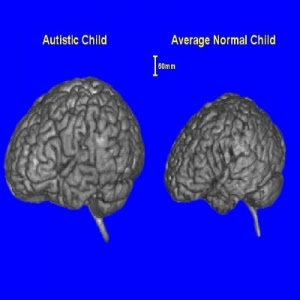Consider a modern day example of a group of people with brains of higher neuron count:
The brains of boys with autism were heavier and contained two-thirds more neurons than similarly aged males without the disorder, according to a new, post-mortem analysis.In conditions such as autism, the extra brain neurons do not typically provide a competitive advantage, and may represent a malfunctioning "pruning" mechanism of excess neurons sometime after birth.
The study, while small, suggests that brain overgrowth may be occurring in the womb, according to the findings published in the current issue of the Journal of the American Medical Association.
Researchers examined the brains of seven autistic boys, age two to 16, most of which died from drowning. The 16-year-old's cause of death was undetermined and one eight-year-old died of muscle cancer.
When they compared them to a control group of six boys without autism who died in accidents, they found that the brains of autistic boys had 67% more neurons in the prefrontal cortex and were nearly 18% heavier than normal brain weight for age. _Cosmos
Consider homo neandertalis, otherwise known as the neanderthal: At birth, the brains of neanderthals were of comparable size as the brains of modern humans. But by adulthood, the brains of neanderthals were larger.
Consider that new anthropological data places modern humans in Europe at a much earlier time than previously believed, allowing roughly 15,000 years of coexistence between homo sapiens sapiens and homo neandertalis in Europe. Over that time period, mating between sapiens and neandertal becomes somewhat likely.
Scientists believe that sapiens and neandertal did indeed interbreed. They further believe that neandertal dna persists in all modern humans except Africans. And these neandertal genes may even play an important role in sapiens' immune systems.
But what else are these neandertal genes doing? In fact, human genetics is still at such an infantile stage that geneticists have very little idea what effect neandertal genes have on the modern human phenotype. Could some rare neandertal genetic or epigenetic sequences play a role in the postnatal neuronal pruning of human brains? Could autistic brains with higher neuron counts indicate the influence of neandertal "gene ghosts" influencing the bodies of modern human children?
Or are these larger brains in some autistic children a sign of a new species trying to emerge?
If there is no advantage to the trait, it is not likely to go anywhere, evolutionarily speaking. But if the excess neurons were able to somehow integrate and add functionality and power to the brains of these autistics, an advantage might well exist in a modern society where food is plentiful and meeting mental challenges were more important to fitness than meeting physical challenges.
Am I Sirius? No, Sirius is a star, and I am but a mere human, and a whimsical one at that. The idea is to allow your mind to make associations, both narrow and wide. They can always be pruned down later. Unless, of course, your brain is autistic.

No comments:
Post a Comment